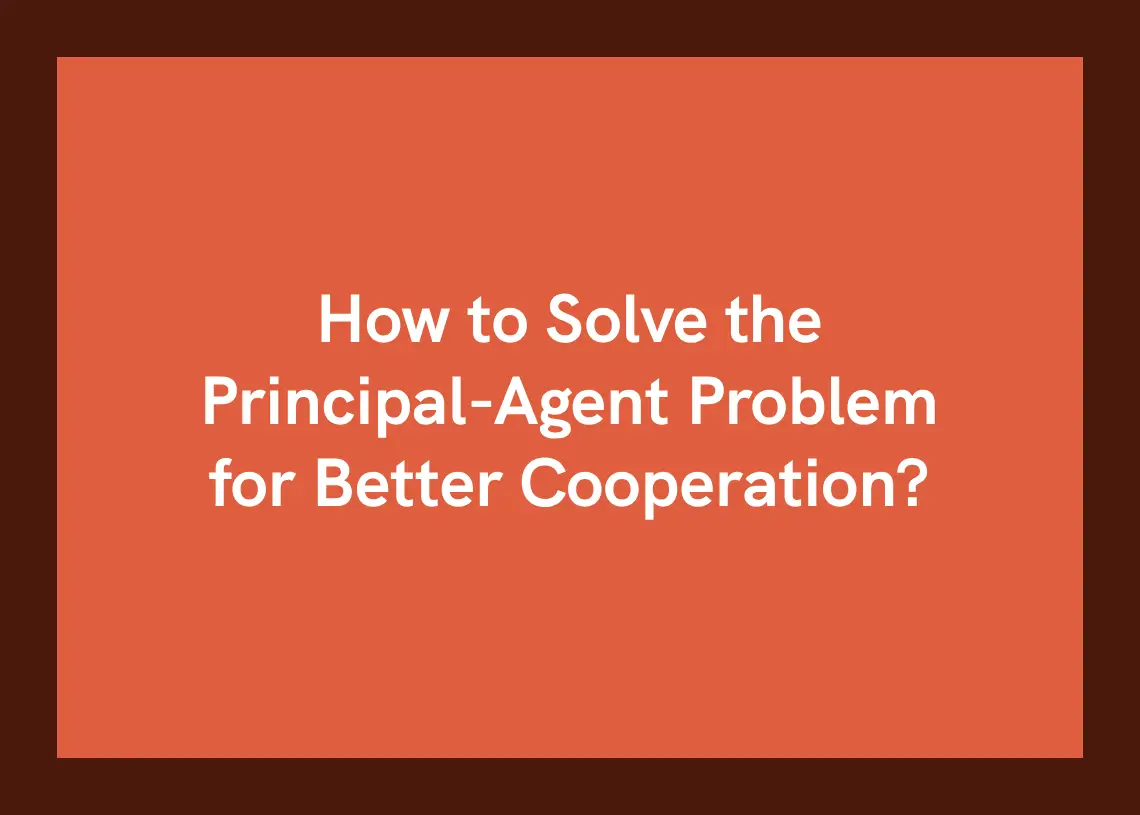The principal-agent problem is a common issue when it comes to business and management. It is essentially the conflict of interest that arises when one party acts on behalf of another party and the interests of both parties are not aligned. This problem can lead to various negative outcomes, such as decreased productivity, loss of trust, and even fraud.
To solve the principal-agent problem, it is crucial to have a solid understanding of the problem and its underlying causes. In this blog post, we will explore some effective strategies that can help overcome this issue and ensure the smooth functioning of your business or organization. We will discuss the importance of establishing clear goals and objectives, effective communication, and proper incentives and rewards systems.
Moreover, we will also highlight the role of leadership in resolving the principal-agent problem. Good leadership can foster a culture of accountability, transparency, and trust, which can help mitigate conflicts of interest and promote the interests of both parties.
Solving the principal-agent problem requires a combination of strategic approaches and robust communication between the principal and agent.
Earn a certificate in your dream career for an affordable price at IAP Career College today!
Define the principal-agent problem
The principal-agent problem is a common issue in any organization where one party, the principal, hires another party, the agent, to act on their behalf. The problem arises when the agent’s interests conflict with those of the principal, leading to moral hazard and adverse selection.
Various methods can mitigate the principal-agent problem, such as implementing incentive structures that align the agent’s interests with those of the principal, establishing clear goals and expectations, and monitoring the agent’s actions to ensure they are acting in the best interest of the principal.
Developing effective communication channels between the principal and agent is also essential to ensure that both parties are on the same page. By taking proactive measures to address the principal-agent problem, organizations can increase the likelihood of achieving their desired outcomes and reduce the risks associated with hiring agents to act on their behalf.
In conclusion, solving the principal-agent problem requires a multifaceted approach that requires careful planning, communication, and management to ensure that the agent’s interests align with those of the principal.
Identify potential sources of conflict
Identifying potential sources of conflict is a crucial step in solving the principal-agent problem. This problem arises due to a misalignment of interests between the principal, who delegates decision-making authority to the agent, and the agent, who acts on behalf of the principal.
Conflicts can arise when the agent’s interests differ from those of the principal, leading to suboptimal outcomes. To address this issue, it is essential to identify potential sources of conflict that may arise in the principal-agent relationship.
This can be achieved by analyzing the incentives and goals of both parties, as well as any power imbalances that may exist. Once potential sources of conflict are identified, steps can be taken to mitigate them, such as establishing clear performance metrics, aligning incentives, and creating a system of checks and balances to ensure accountability.
Proactively addressing potential conflicts can strengthen the principal-agent relationship and increase the likelihood of achieving optimal outcomes.
Establish clear expectations and goals
The principal-agent problem is a common issue in business that can lead to misaligned incentives, decreased productivity, and a lack of trust between parties. To solve this problem, it is essential to establish clear expectations and goals upfront.
This means defining the scope of work, outlining specific performance metrics, and establishing a timeline for completion. By doing so, both the principal and agent can have a clear understanding of what is expected and can work towards achieving the same goals.
It is also important to regularly communicate and assess progress towards these goals, making adjustments as necessary to ensure success. Through clear expectations and goals, the principal-agent problem can be effectively managed and overcome.
Implement appropriate incentives and rewards
How to solve Principal-agent problem? One of the most effective ways to address the Principal-agent problem is by implementing appropriate incentives and rewards. Incentives and rewards are essential tools that organizations can use to align the interests of principals and agents.
The key is to design incentive systems that motivate agents to act in the best interests of the organization, rather than just their own personal interests. Incentives can be both monetary and non-monetary, and can range from bonuses and commissions to recognition and promotions.
However, the organization must ensure that it closely links incentives to the most relevant performance measures for achieving its goals. This will ensure that agents are motivated to achieve the desired outcomes and that incentives and rewards effectively address the Principal-agent problem.
Develop effective communication strategies
Effective communication strategies are an essential part of solving the principal-agent problem. This problem arises when there is a misalignment of interests between the principal, who is the owner or manager of a business, and the agent, who is an employee or contractor hired to perform tasks on behalf of the principal.
To address this issue, it is crucial to develop communication strategies that promote transparency and encourage open dialogue between the principal and agent. This can include regular check-ins, clear expectations and goals, and providing opportunities for feedback and input.
It is also important to establish clear lines of authority and decision-making processes, as well as defining roles and responsibilities. By developing effective communication strategies, principals can minimize the risk of misunderstandings, foster trust and mutual respect, and ultimately improve the overall performance of their business.
Regularly monitor and evaluate the performance
One effective way to solve the principal-agent problem is to regularly monitor and evaluate the performance of the agent. This can be done by setting specific goals and benchmarks and then measuring the agent’s progress towards these goals over time.
It is important to ensure that the goals set are realistic and achievable and that they align with the interests of the principal. Regular monitoring and evaluation allow the principal to identify any potential issues early on, and to take corrective action if necessary.
It also provides an opportunity for feedback and communication between the principal and the agent, which can help to build trust and strengthen the relationship. Regular monitoring and evaluation are essential components of any strategy to solve the principal-agent problem. It helps to align the interests of both parties and hold the agent accountable for their actions.
Use third-party intermediaries if necessary
One effective way to solve the principal-agent problem is by using third-party intermediaries. These intermediaries act as neutral party that can monitor and enforce the terms of the agreement between the principal and agent.
This effectively reduces the information asymmetry and moral hazard that can arise in principal-agent relationships. Intermediaries can take on various forms, such as auditors, legal counsels, or even independent consultants.
Their role is to ensure that both parties comply with the terms of the agreement and that the agent acts in the best interest of the principal. However, it is important to note that the use of intermediaries comes at a cost, and in some cases, it may not be necessary if there is a high level of trust between the principal and agent.
Ultimately, the decision to use third-party intermediaries should be based on a careful assessment of the risks involved and the potential benefits that can be gained.
Foster a culture of trust
One of the most effective ways to solve the principal-agent problem is by fostering a culture of trust within the organization. When employees trust their superiors and management, they are more likely to act in the best interests of the company, rather than their own self-interest.
To create a culture of trust, management should communicate openly and clearly with employees, be transparent about decision-making processes, and ensure that their actions align with their words. Additionally, management should empower employees by giving them autonomy and ownership over their work, and by recognizing and rewarding their contributions.
Building a culture of trust can minimize the principal-agent problem and enable the organization to operate more effectively and efficiently.
Resolve disputes in a timely manner
Resolving disputes in a timely manner is a critical step in solving the principal-agent problem. This issue arises when agents, who are tasked with completing certain responsibilities on behalf of principals, have conflicting interests with the principals.
In such cases, it is important to have a mechanism in place that allows for the resolution of any disputes that may arise. This could involve setting up a system of reporting, monitoring, and evaluating the performance of agents, along with providing regular feedback.
In addition, it is important to have clear and concise contracts in place that outline the expectations and obligations of both parties. Having these mechanisms in place and resolving disputes in a timely manner can minimize the principal-agent problem and enable both parties to work towards achieving common goals.
Continuously reassess and refine strategies
Continuously reassessing and refining the strategies that we implement is an important strategy for solving the Principal-agent problem. This involves regularly reviewing the objectives and goals of the organization and evaluating whether the current strategies are effective in achieving them.
In addition, it is essential to monitor the performance of both the principal and the agent and to make necessary adjustments to improve their alignment. This may involve restructuring the incentives, improving communication channels, and providing appropriate training and support to the agents.
By continuously reassessing and refining the strategies, organizations can ensure that they are effectively addressing the Principal-agent problem and achieving the desired outcomes.
Conclusion: How to solve the Principal-agent problem?
In conclusion, the principal-agent problem is a complex issue that can arise in any organization where there is a separation of ownership and control. The key to solving this problem is to align the interests of the principal and the agent.
We can use several mechanisms such as performance-based incentives, monitoring and supervision, and effective communication to align interests and reduce information asymmetry. Ultimately, it is crucial for organizations to recognize the existence of the principal-agent problem and take proactive measures to mitigate its effects in order to maintain trust and achieve mutual success.





